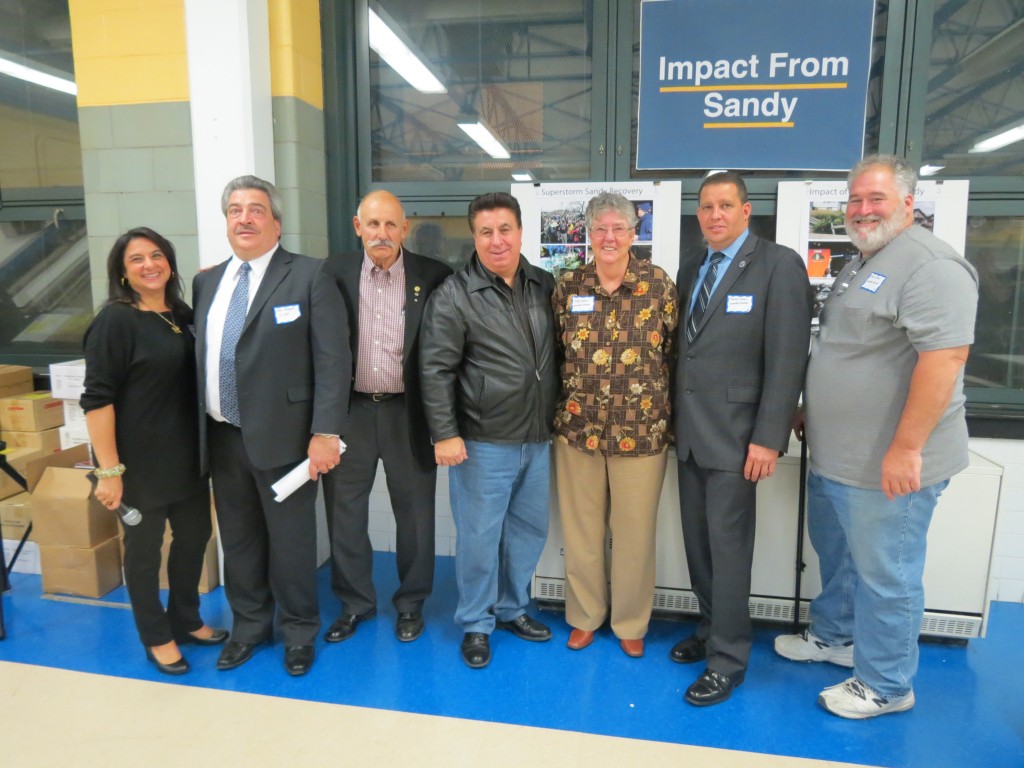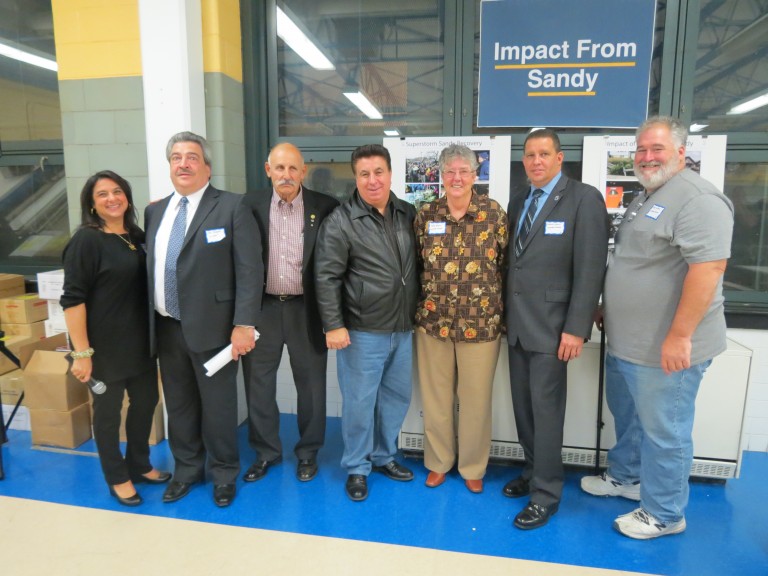
Howard Beach’s New York Rising Community Reconstruction Program committee members gathered at PS 146 this week to speak to the public about crafting a plan that will better protect the community during natural disasters, such as Hurricane Sandy. Anna Gustafson/The Forum Newsgroup
For Howard Beach residents Valerie Messana and JoAnn Ambrosio, this week’s meeting about preventing the kind of devastation Hurricane Sandy wrought was, to them, more than just consultants and maps and ideas. It was about changing their hometown so they would never again have to utter the words: I lost everything.
“I don’t want four and a half feet of water in my house again,” Messana said at Monday night’s meeting of the New York Rising Community Reconstruction Program. “I lost everything – photos I can never get back, everything. My daughter was living upstairs with her infant twins and a two and a half year old, and we were homeless for three months.”
Messana was one of several dozen people who gathered at PS 174 for the meeting of Gov. Cuomo’s New York Rising program that will give communities across the state, including Howard Beach and Broad Channel, funding to create and at least partially implement a plan that aims to protect communities from events like Hurricane Sandy. Howard Beach is slated to receive $18.3 million from the state as part of the program. In Howard Beach, a New York Rising committee has been meeting since the summer to craft ideas about everything from designating a place for the community to gather for information during or immediately after a disaster to flood mitigation.
“What happened first that night of the storm – losing power, dealing with the sewage backup and then the surge – we want to prevent that from happening as severely as it did,” said John Calcagnile, an architect from Howard who is on the New York Rising committee.
And while the $18.3 million certainly will not fund all the projects the community needs – such as large storm barriers or raising the elevation of the coastline – Calcagnile stressed, “it could be a start to wake everybody up to what needs to happen.
“It could bring a lot more hope,” he said.
And, residents attending the meeting said, hope is something that is sorely needed after a year of dealing with devastated homes, uncooperative insurance companies, and feeling as though the federal and state governments abandoned them.
“If this happened again, we would all kill ourselves,” said Ambrosio, who lost two houses in Howard Beach during last October’s storm.
Consultants partnering with the state received feedback from residents as to what type of a plan needs to be crafted to prepare the area for any future natural disasters. Attendees suggested a wide variety of ideas, from potentially designating such buildings as schools to be official community centers during disasters where people would know to go to receive information about everything from where they could get food and shelter to locating loved ones. Such a lack of information was especially problematic during Sandy, when residents lost power, couldn’t use their cell phones and didn’t know where to immediately turn for help.
“There was so much miscommunication flowing down to use, it was unbelievable,” committee member Frank Gulluscio said during the meeting. “There wasn’t a communication hub.”
Another committee member, Community Board 10 Chairwoman Betty Braton, added that while schools were rendered unusable – their insides devastated by flooding and power outages – “their walls could’ve been sign posts where we all could get information.”
Frances Scarantino, another committee member and president of the Rotary Club of South West Queens, noted that it is crucial to get residents involved in the New York Rising program to best figure out how to protect the community.
“We have to identify what actually happened that day, that night, and in the aftermath,” said Scarantino. “Next, how do we make the community more resilient? And we have to identify projects to prevent it from happening again.”
With the community’s insurance rates expected to soon skyrocket, some residents at the meeting said they have often felt despondent and wondered how much of a community there would be to save.
“People say, ‘OK, sell your house, but who’s going to buy it with those insurance rates?” Messana asked. “Now what do we do? We’re stuck.”
Already, Calcagnile said residents are leaving the area out of fear they will no longer be able to afford to live there.
“People are fleeing; that’s the sad part,” he said.
There will be three more New York Rising meetings in Howard Beach. For more information, visit www.stormrecovery.ny.gov/community-reconstruction-program.
By Anna Gustafson

